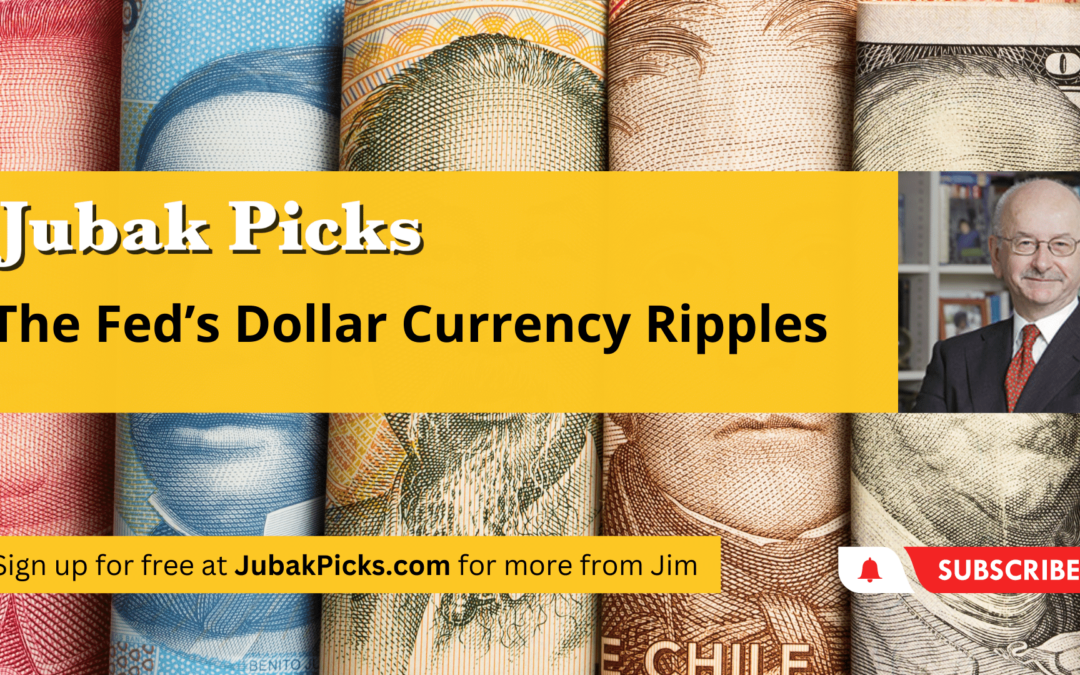
August 17, 2023 | Daily JAM, Videos |
Today’s video is The Fed’s Dollar Currency Ripples. Monday, August 14 was a big day in the currency market with the currencies of China, Argentina, and Russia all making headlines. China’s yuan fell to its lowest level against the dollar since November. The Argentine peso collapsed as the government looks like it is losing its fight against inflation. The Argentine government raised rates by 21 percentage points to 118% and devalued the peso by another 18%. This immediate cause of the drop in the Peso was a surprise victory by a libertarian in a recent primary race for president. Argentine debt due in 2046 fell $0.04 to $0.28 on the dollar. Russia had an emergency rate increase of 350 basis points to a benchmark interest rate of 12%. Of course, none of these things are solely attributable to the dollar’s strength. China’s economy is slowing, Argentina is dealing with economic chaos, and Russia is feeling the effects of international sanctions due to the war in Ukraine. But, the dollar is very strong because it’s safe. The U.S. economy is showing surprising signs of growth with inflation going down and interest rates expected to remain high for some time. The popularity of the dollar in currency markets is creating big economic ripples. China, Argentina, and Russia are the tip of a very large iceberg. The World Bank and IMF say that 40% of the world’s poorest countries are on the verge of default. It’s time to watch your dollars, yuan, pesos, and developing country currencies closely.

January 31, 2023 | Daily JAM, Videos |
Today I posted my two-hundred-and-thirtieth YouTube video: Trend of the Week Watch the Yuan. This week’s Trend of the Week: Watch the Yuan. China controls one of the two largest treasury portfolios in the world, and the strength of the yuan affects treasuries worldwide. Right now, the yuan is under pressure from many different sources that I’m not sure the market is taking into account. China’s battle with high rates of COVID has left the Chinese government with two choices: either let the yuan fall and import inflation, or spend money to support the yuan causing inflation problems on the other end. It’s clear to me that China will provide stimulus to counteract the slowing economy from the COVID outbreak, which will put added pressure on the yuan. Additionally, as Russia tries to make up for losses in its oil exports, it really only has one option: sell from its huge currency reserve. Due to global sanctions, the only currency it can trade is the yuan. Expect to see Russia selling off its yuan to buy rubles in order to support its own currency. All these factors are putting pressure on the yuan. There’s a lot to watch in global currencies right now, including strange things happening with the yen in Japan and the dollar under pressure as the U.S. faces the debt ceiling crisis. Keep an eye on the Treasury market.

January 30, 2023 | Daily JAM, GDX, GDXJ, GLD, GOLD, Jubak Picks, Perfect Five-ETFs, Volatility |
With the Federal Reserve seemingly winding down its cycle of interest rate increases, a stronger dollar is no longer the big currency market story. Gold is. Gold is back. And for at least the next 3 to 6 months.

January 25, 2023 | Daily JAM, Videos |
Today I posted my two-hundred-and-twenty-eighth YouTube video: Don’t Pay for the Illusion of Control. Today’s topic is: Don’t Pay for the Illusion of Control. The market is rallying on the expectation that the Fed will reduce its interest rate increases to just 25 basis points on February 1, after the previous hike of 50 basis points. The belief is that the Fed will continue to wind down rate increases until they eventually stop after having vanquished inflation without tanking the economy. I have a few concerns about this rally. The market has priced this as 100% likely, so if the Fed disappoints with another 50 basis point increase, the market will not react well. Another huge problem with the idea that the Fed is controlling the market is this: there is no controlling this economy. Fed rates are just one of the factors in a very complicated economic picture right now. Here is a sample of some of the other things that can and will affect the market: as the Fed has reduced its balance sheet (and therefore reduced its supply of treasuries), the debt ceiling crisis has resulted in a lower supply of treasuries from the Treasury, and banks are moving their money to reserves, while money market funds are looking to buy bonds and there are none to be found. On a global scale, China’s battle with COVID could cause as many as one million deaths and slow that economy, while Beijing pours money into its financial system. Japan has seen an unusual surge in inflation and the fighting in Ukraine will likely get worse this spring as Russia looks to regain control of the war. All this to say, the Fed does not control the economy and I wouldn’t put all my eggs in the Fed basket.

January 19, 2023 | Daily JAM, Perfect Five-ETFs, Videos, Volatility |
Today I posted my two-hundred-and-twenty-sixth YouTube video: Quick Pick Sell UUP. This week’s Quick Pick: Sell UUP–the dollar ETF. I had the Invesco DB US Dollar Index Bullish Fund (NYSEARCA: UUP) in my portfolio through 2022 while the dollar was doing well but the dollar has recently taken a turn South and I’m now saying: Sell. UUP was going up while expectations were that the Fed was going to continue to raise interest rates, but now that the market believes (rightly or wrongly) that the Fed will be slowing their rate hikes, we’ve seen it move down by about 1.22% for 2023. This will likely continue to be the case as other countries maintain steady interest rates or even raise them to fight inflation (Watch the European Union) and as we edge closer to the debt ceiling cliff. U.S. Secretary of the Treasury, Janet Yellen thinks the government can shift things to cover us through June, but after that, if the debt ceiling isn’t raised by Congress, the United States will not be able to borrow enough money to meet all of its obligations. I think we’ll walk right up to that cliff, but I sincerely hope we don’t go over it. For now, I’m selling UUP and I’ll be looking for a gold ETF to replace it. More on that to come!

October 1, 2022 | Daily JAM, Special Reports |
Today, October 1, I’ve gone back through this Special Report to update any parts of my calendar in light of what we’ve learned about the economy, about Federal Reserve interest rate policy, and about the global economy in the last few weeks. This update includes my take on the August jobs report and the September 21 meeting of the Fed. (It’s a complete revision of the original so changes are in the body of the original text.) It is different this time. And it’s likely to “be different this time” for the next five years or so. And you need an investment strategy for that period.

September 28, 2022 | Daily JAM, Videos |
My one-hundred-and-eighty-ninth YouTube video: “From a Bear Market to a Global Financial Crisis” went up today. To me, it increasingly looks like we’re going from a bear market to a global financial crisis. The signs of an upcoming global financial crisis are there: volatility in the currency markets, the decline in nearly every currency against the dollar, the World Bank lowering its estimates of economic growth around the world, and global inflation due to food and energy. A good way to track the “progress” toward a global financial crisis0 is to look at emerging markets. The iShares MSCI Emerging Markets ETF (EEM) and iShares MSCI India ETF (INDA) both saw accelerated declines starting around September 12, and South Korea has been down since mid-August. Many key emerging markets rely on in-flows of foreign capital to balance their accounts but the flow of that money has slowed, as investors are risking less internationally and keeping their funds closer to home. Right now, we’re seeing a global “Whac-a-Mole”, where individual countries pop up as problems. But if more financial individual crises pop up simultaneously and at a more rapid pace, we’ll have a global financial crisis on our hands. Oh, goody. Something more to worry about.

September 28, 2022 | Daily JAM |
The yield on the 10-year Treasury fell 25 basis points to 3.75% today, September 28. The yield on the very policy-sensitive 2-year Treasury dropped to 4.08% from 4.28% yesterday. And stocks climbed. At the close in New York, the Standard & Poor’s 500 was up 1.97% and the Dow Jones Industrial Average was higher by 1.88%. The NASDAQ Composite had climbed 2.05% and the NASDAQ 100 had gained 1.97%. The small-cap Russell 2000 was ahead by 3.17%. And what was the cause of this move upward after so many days of marching in the other direction?

September 5, 2022 | Daily JAM, Special Reports |
Today, September 5, I’ve gone back through this Special Report to update any parts of my calendar in light of what we’ve learned about the economy, about Federal Reserve interest rate policy, and about the global economy in the last few weeks. This update includes my take on the August jobs report and on recent Fed-speak from the Jackson Hole conference and after. It is different this time. And it’s likely to “be different this time” for the next five years or so. And you need an investment strategy for that period.

August 15, 2022 | Daily JAM, Morning Briefing |
China’s factory output and consumer spending both slowed in July, new numbers released today by the National Bureau of Statistics showed. Industrial production rose 3.8% from a year ago. That’s lower than June’s 3.9% year-over-year rate and below economists’ forecast of a 4.3% increase. Retail sales growth slowed to 2.7% in July, lower than economists’ projection of 4.9%.

July 17, 2022 | Daily JAM, Friday Trick or Trend |
The dollar is likely to get another boost from the Bank of Japan and the European Central Bank this week. On Thursday, the European Central Bank is likely to report its first interest-rate increase in more than a decade. But the increase is likely to be just 25 basis points. That will be a stark reminder of how far behind the Federal Reserve, which raised interest rates 75 basis points in June and is expected to increase rates by another 75 basis points at its July 27 meeting. On Thursday the Bank of Japan is expected to keep its benchmark interest rates at its current low, low, low level.

July 6, 2022 | Daily JAM, Uncategorized, Videos |
My one-hundred-and-fifty-fourth YouTube video “Strong Dollar Hits Stocks–3 Things to Do” went up today. The biggest factor driving falling prices in commodities (ahem, oil) is the rising strength of the dollar. Believe it or not, the US economy is faring better than other trading partners. That combined with rising interest rates makes for a stronger dollar. In this video, I provide three picks to address this issue as I continue to expect rate hikes from the Fed.














